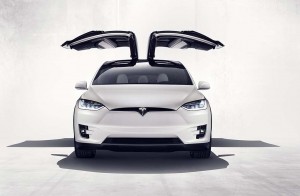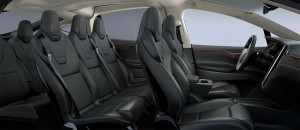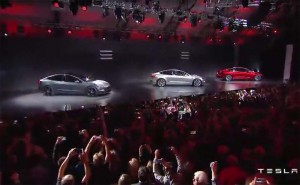Already struggling to overcome a series of production start-up problems, Tesla is recalling virtually all of its new Model X battery SUVs, the maker confirmed.
The recall is the result of a faulty latch in the third row that could cause the seats to come loose and fall forward in a crash. The news follows Tesla’s acknowledgement that it has run into a series of problems ramping up production of the Model X which was launched last September, about two years later than originally planned.
The various problems with the Tesla Model X have raised concerns about the Silicon Valley automaker’s even more ambitious plans for its next offering, the Model 3, which is expected to reach production in late 2017. More than 300,000 potential customers have placed initial, $1,000 deposits for the planned battery sedan since its unveiling on March 31.
The recall of the Tesla Model X was ordered after the third-row seats failed to meet a strength test required by the European Union. Tesla says the test is more difficult than the standards in the U.S. – which the seats passed.
The European Model X has not yet been shipped, and the seats for that version will be updated. Tesla said it is recalling the American version out of an abundance of caution. Tesla Vice President Jon McNeil telling reporters, “We’ve had no issues with any failures in the field.”
A notice will be sent to owners advising them of the recall which, Tesla expects, will take about five weeks to complete. The repair, which will be completed at no charge to the customer, is expected to take about two hours to complete. Both seats will be replaced.
The supplier who produced the seats, Futuris, is expected to assume all costs for Tesla, a significant factor for a company that has been operating in the red due to hefty product development costs. Tesla is not expected to reach breakeven until at least the upcoming Model 3 launch using standard industry accounting methods.
The auto industry, as a whole, has been facing a rapid increase in recalls in recent years – the total number of vehicles affected in the U.S. has jumped to record levels two years in a row. Tesla has, by comparison, had relatively few safety-related recalls since launching the original Model S battery sedan several years ago.
In 2014, the company recalled more than 29,000 of the sedans due to a potential fire hazard. Last November, another 90,000 Model S sedans were recalled because of faulty front seat belt latches. Tesla also ordered revisions to the shielding around the lithium-ion battery pack used in the Model S after several well-publicized fires. That was not officially considered a recall, however.
The new service action covers all of the battery SUVs built through March 26. The size of the Model X recall might actually have been larger had Tesla been able to hold to its original production plans. But due to a variety of issues, the Silicon Valley automaker said it only delivered 14,820 of the SUVs during the January to March quarter.
(“Hubris” caused slow launch of Model X, concedes Tesla. Click Here for the story.)
It blamed a number of problems, including the company’s own “hubris,” as well as supplier-related parts shortages, and technical issues with its panoramic windshield, sliding seats and the Model X’s distinctive “falcon wing” doors. There were significant initial problems with the design – which led Tesla to file a lawsuit against the Swiss company that designed the original door mechanism.
Despite the slow ramp-up, consumer interest in the brand has largely been unaffected. Tesla CEO Elon Musk noted during the March 31st unveiling of the Model 3 that the company had already received more than 100,000 advance orders. That figure 250,000 within 36 hours and is now over 300,000 – though it remains to be seen how many of those will actually translate into sales once the vehicle comes to market.
(For a closer look at the Tesla Model 3, Click Here.)
Exactly when that will happen also is uncertain. The normally confident Musk showed a moment of hesitation when suggesting the goal would be late 2017. Some analysts believe Tesla will have trouble getting into production before 2018.
Even so, investors have responded giddily, Tesla’s generally high-flying stock surging 77% from a February low before settling back this week. It closed down at $249.42 on Monday.
(Tesla could run out of federal $7,500 tax credits before launch of the Model 3. Click Here for the story.)




